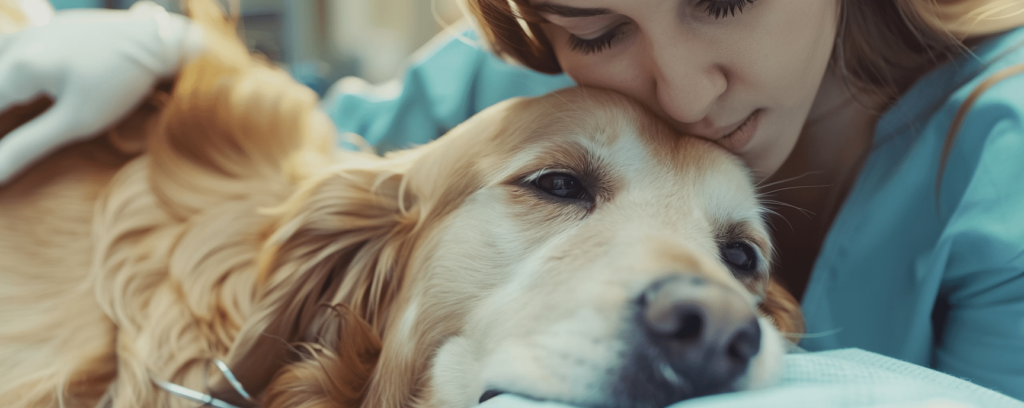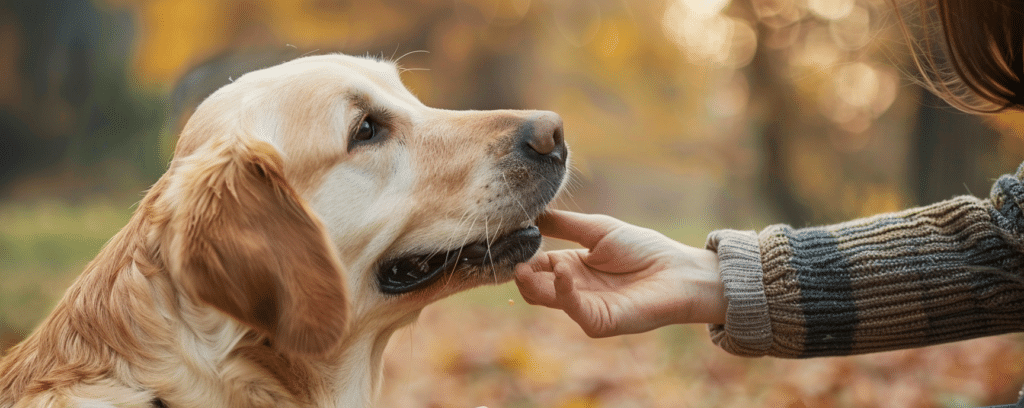Steps to Take When My Dog Was Bitten by Another Dog
Last updated Monday, June 17th, 2024

This article delivers concise, step-by-step advice covering first-aid care, recognizing when professional veterinary assistance is needed, and how to protect your pet’s health moving forward when dealing with the unfortunate situation of having your dog bitten by another dog. We hope that this never happens to you, but if it does, please refer to this!
Key Takeaways
- Swift recognition and immediate care are crucial when a dog is bitten; look for signs of trauma such as swelling, redness, and behavioral changes to assess your dog’s condition.
- Initial steps post-bite should include calming your dog, assessing the wound’s severity, providing first aid, and seeking veterinary care to manage the risk of infection and complications.
- Preventive measures like understanding dog body language, proper training and socialization, and avoiding high-risk situations can reduce the chances of future dog bites and related injuries.
Recognizing Swelling in Your Dog
When your dog is bitten, immediate action is crucial. First, you must recognize the signs of trauma. Swelling is a red flag signaling that your dog has been hurt, often accompanied by redness and warmth due to increased blood flow to the area. Spotting these early warning signs can be the difference between a quick recovery and long-term complications.
So, what clues should you be on the lookout for to identify a dog bite wound, and how can you tell if your dog’s behavior is a cause for concern?
Identifying the bite wound
Bite wounds can vary immensely, from superficial scrapes to deep punctures, often found on the neck or ears. The telltale signs of a bite wound include:
- Holes in the skin
- Bleeding
- Redness
- Swelling
These signs should prompt immediate attention. Remember, the damage may be more than skin deep; bruising beneath the fur can mask the severity of the injury to the skin and soft tissues.
Fast identification is the first step in protecting your dog from further harm.
Observing changes in behavior
A dog’s behavior can speak volumes about its pain level. Look for changes such as increased aggression, fear, reluctance to move, or a negative response to touch—all of which could indicate discomfort. You might also notice your fearful or anxious dog becoming more withdrawn, lethargic, or experiencing changes in eating and sleeping habits.
These subtle shifts in demeanor are your dog’s way of telling you something is wrong.
Monitoring for additional symptoms
Apart from pain and swelling, be on high alert for symptoms suggesting a tissue infection, such as pus or an unusual discharge. These additional symptoms require prompt veterinary attention to avert more serious health issues.
Your dog’s quick recovery hinges on your vigilance and swift action.
Immediate Actions to Take After a Dog Bite
Once you’ve identified that your dog has been bitten, what you do next can significantly influence their recovery. Your immediate goal is to keep the situation under control—calming your dog, gauging the wound’s severity, and applying first aid. Each moment is precious, and your actions must be deliberate and calm to avoid exacerbating your dog’s stress.
Calming your dog down
Your dog will likely be in distress, so it’s important to help them find their bearings. Give them space, limit interactions, and introduce calm situations to rebuild their sense of security. This approach not only soothes your pet but also makes it easier for you to handle the situation and prevents further injury.
Assessing the severity of the bite
A thorough assessment of the bite allows you to decide the best course of action. Consider the location, depth, and any signs of severe damage, such as shearing effects or internal injuries,. Remember, the quicker you evaluate and respond to the bite, the better your dog’s chances of a full recovery.
Applying first aid measures
Immediate first aid is critical. Gently wash the bite with soap and water, disinfect it with hydrogen peroxide or similar, and apply an antibiotic ointment. These steps will help stave off infection and set the stage for healing, but they are only the beginning.
Professional veterinary care is crucial for a swollen bite wound, and it’s essential to seek it out without delay.
The Importance of Veterinary Care for Swollen Dog Bites
While first aid is a key immediate response, the expertise of a veterinarian is indispensable for a swollen dog bite. They can accurately assess the risk of infection, potential complications, and provide the necessary treatments to promote healing and prevent further issues. Taking your dog to the vet may seem daunting, but it’s a step that cannot be overlooked.
Risk of infection
The risk of infection from a dog’s mouth bacteria is significant, especially in the case of dog bite wounds. The warm, enclosed environment of a puncture wound only exacerbates this. An untreated infected bite wound can lead to systemic issues, including bone infections and sepsis—a serious health risk that underscores the need for immediate veterinary care for wounds in dogs.
Potential complications
Without prompt treatment, complications such as abscesses, cellulitis, or even sepsis can arise, necessitating more intensive medical intervention. These potential issues are not to be taken lightly, as they can have lasting impacts on your dog’s health and quality of life.
Proper treatment and follow-up
Following the veterinarian’s treatment plan, including cleaning the wound and administering antibiotics, is essential for a full recovery. Even if the wound appears to heal, completing the prescribed antibiotic course is vital to ensure the infection doesn’t return.
Your vet may also recommend further steps for treatment, such as surgical intervention, which must be followed diligently for the best outcome.
What to Expect During the Vet Visit
Navigating a vet visit after a dog bite can be stressful, but knowing what to expect can ease some of that anxiety. From the initial examination to potential diagnostics and treatment options, being prepared can make the process smoother for both you and your dog.
Physical examination
The physical examination is comprehensive, assessing the wound’s depth, checking for physical injuries, and gathering a history of the bite incident. This examination is crucial in determining the extent of the injury and the best course of action for treatment.
Diagnostic tests
Diagnostic tests such as X-rays or ultrasounds may be necessary to identify injuries not immediately visible and to tailor antibiotic treatment to the specific bacteria present. These tests provide a clearer picture of the injury’s severity and help in shaping an effective treatment plan.
Treatment options
Your vet may prescribe antibiotics and painkillers to fight infection and manage pain,. In some cases, surgical intervention may be required to clean the wound and repair any damage.
Understanding these treatment options will help you make informed decisions about your dog’s care.
Caring for Your Dog at Home After a Bite Wound
After visiting the vet, caring for your dog at home is your next responsibility. This involves administering medication, keeping the wound clean, and providing comfort to help your dog heal both physically and emotionally.
Administering medications
Following your vet’s instructions for medication administration is critical. This includes giving pain relief as needed and completing the course of dog antibiotics to prevent the infection from recurring. Stopping antibiotic treatment early can lead to complications. Remember to administer medication properly, using tools like pilling devices, and to follow instructions regarding food.
Cleaning and monitoring the wound
Keeping the wound clean and preventing infection is paramount in the healing process. Regularly clean the wound and monitor for signs of infection such as increased swelling, redness, or discharge,.
The use of an e-collar may be necessary to prevent licking and further contamination.
Providing comfort and support
Your dog will need a safe and calm environment to recover. Provide a quiet space with familiar comforts and gradually reintroduce routine activities to help your anxious dog regain their confidence. Should your dog exhibit persistent stress or anxiety, consider seeking professional help.
Preventing Future Dog Bites and Swelling
Preventing future dog bites involves understanding dog behavior, recognizing the signs of a threatening dog, effective training, and steering clear of risky situations. These proactive measures, also known as dog bite prevention strategies, can significantly reduce the chances of another traumatic event.
Understanding canine body language
Being able to read your dog’s body language is crucial in preventing bites. Recognize signs of aggression or discomfort such as baring teeth and stiffness, as well as indicators of fear or anxiety like licking lips and crouching.
Understanding that any dog, including other dogs, can bite, regardless of breed or past behavior, is a key part of preventing bites.
Training and socialization
Socialization and obedience training help control your dog’s reactions in different situations and reduce the risk of aggression. Training your dog to communicate discomfort without resorting to biting is an important aspect of preventing future incidents.
Avoiding risky situations
Avoiding situations that might lead to aggression is another effective prevention strategy. In the event of a fight, use distraction rather than direct intervention and avoid actions that could be perceived as threats.
Legal and Insurance Considerations
Dog bites can have legal and insurance implications that shouldn’t be overlooked. Reporting the incident, understanding your responsibilities under local laws, and having adequate insurance coverage can help mitigate the financial and legal consequences of a bite.
Reporting the incident
Promptly reporting the bite to local authorities and gathering information from the other dog owner is essential for documentation and any future claims. This report can be crucial in legal and insurance matters, and it also contributes to community safety by preventing future incidents.
Understanding local laws and regulations
Familiarize yourself with the local dog bite laws, which vary by region and can affect liability and legal actions. Knowing these laws can help you navigate any legal processes following a bite incident.
Pet insurance options
Pet insurance can be a financial lifesaver in the aftermath of a dog bite. Review your policy to ensure it covers injuries caused by other animals and consider additional liability coverage if necessary, especially if you are the other pet owner.
Frequently Asked Questions
What are the first signs of a dog bite I should look for on my pet?
If you notice holes in the skin, bleeding, swelling, or redness on your pet, these are clear signs of a dog bite that require immediate attention. Take your pet to the vet for proper evaluation and treatment.
How can I tell if my dog's bite wound is serious?
You can tell if your dog’s bite wound is serious by assessing its size, depth, location, and looking for any signs of severe damage or internal injuries. Take action if you notice anything concerning.
What should I do if my dog's bite wound starts to swell?
If your dog’s bite wound starts to swell, immediately apply first aid by cleaning and disinfecting the wound, then seek veterinary care for further treatment. Take care of your dog’s health, and act promptly to prevent any complications.
How can I prevent my dog from getting bitten in the future?
To prevent your dog from getting bitten in the future, focus on training, socializing, and understanding their body language to avoid risky situations that could lead to aggression.
Are dog bites covered by pet insurance?
Review your pet insurance policy to see if it covers injuries caused by dog bites, and consider adding extra liability coverage if necessary.











